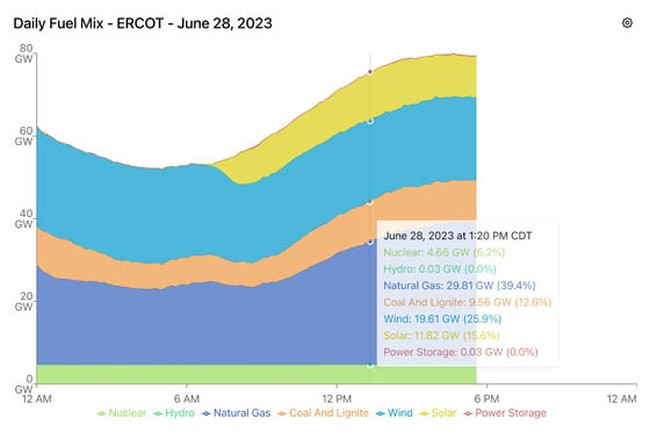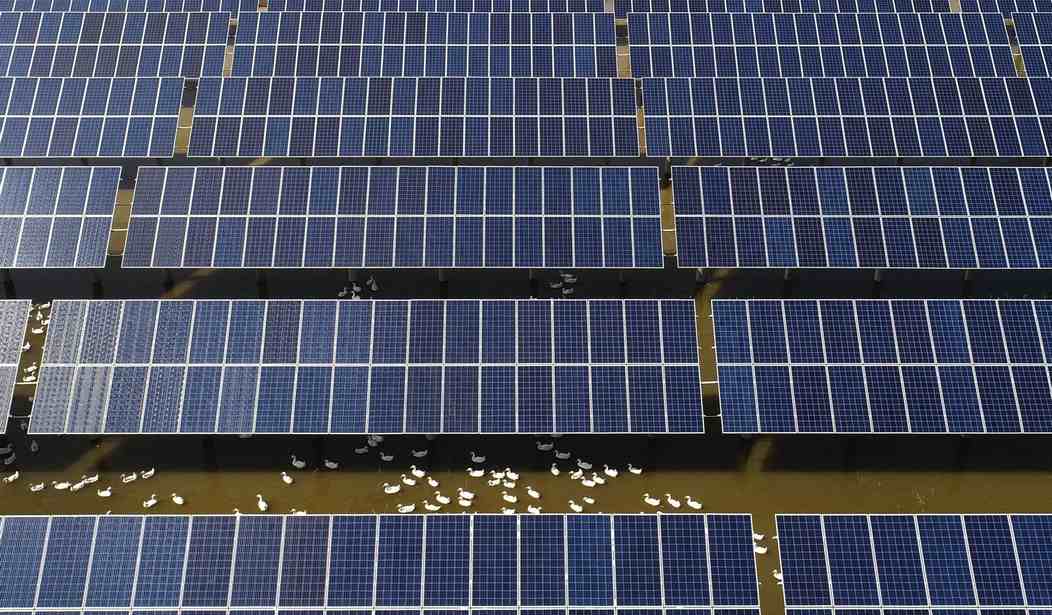In 2020, California experienced blackouts in the midst of a heatwave. As I wrote at the time, part of the reason for the blackouts was an over-reliance on renewable energy.
…it seems pretty clear what happened here. Because of the heat wave there was increased demand. California was able to meet that demand for most of the day Friday and Saturday but several reports note that, because it was cloudy during the day, solar generation was off a bit and as the sun began to set solar sources cut out. Cal ISO simply couldn’t find enough out-of-state sources to make up the shortfall and was forced to order blackouts. Clearly we need more reserve power generation capacity which isn’t wind or solar on hand for situations like this.
What would have been helpful was more nuclear power but until very recently, California has been trying to shut that down as well. Anyway, I bring this up because something quite different happened last month as Texas was sitting under a record heat wave. In case you haven’t heard, Texas became one of the hottest places on earth last month.
Blistering triple-digit temperatures across Texas this week have the state rivaling the hottest locations on the planet, including the Sahara Desert and parts of the Persian Gulf.
Texas has for weeks been baking under a severe, early season heat wave that is now spreading into the Lower Mississippi Valley and parts of the Southeast.
Over the past week, several cities in Texas, including San Angelo and Del Rio, have hit or surpassed 110 degrees Fahrenheit — temperatures that are more common at this time of year in parts of northern Africa and the Middle East.
Rio Grande Village, Texas, in Big Bend National Park, was hotter than Death Valley on Tuesday, according to the National Weather Service. Rio Grande Village was 115 degrees that day, the hottest in the nation, while Furnace Creek in Death Valley recorded 109 degrees, it said.
The situation was serious enough that record numbers of people were winding up in the ER with heat-related issues. All of this meant there was record demand on the Texas power grid.
The Electric Reliability Council of Texas, which manages about 90% of the state’s power grid, reported “unofficial” monthly and all-time records for electricity demand were hit Tuesday as air conditioners whir seemingly around the clock while Texans try to beat the heat.
According to ERCOT, the previous June record for power demand was last year, when 76,681 megawatts were used on June 23. On Tuesday, however, that record was broken when usage peaked at 80,828 megawatts of electricity.
Not only does this figure break the June record, but it also breaks the all-time peak demand record on the ERCOT power grid. That record was previously set on July 20, 2022, with 80,148 megawatts used in one day. That means the record was broken about three weeks earlier than when the last all-time record was set.
The worst case scenario here would have been for electricity demand to spike and for the grid to be overwhelmed and forced to cut power to some areas. But that didn’t happen (at least not so far). And one of the reasons it didn’t happen is that Texas has also been setting records for wind and solar generation this summer.
How has the grid managed to function with more demand placed on it than ever before?
It’s all thanks to the rapid additions of solar, wind, and grid-scale battery storage in the last two years. Texas has added almost 3,000 MW of wind since Winter Storm Uri, and utility scale solar in the state has doubled every year since 2020, with nearly 10,000 MW of new solar added since 2020.
And here is the amazing statistic that few people know – Texas accounted for nearly 70% of grid battery additions in the U.S. in the first three months of 2023, resulting in a total capacity of 3,300 MW, almost all of which have come online since early 2021…
Solar and wind provided 35% of statewide power last Tuesday and generated a record 31,500 MW Wednesday, which more than covered the 9,600 MW of electricity lost when extreme heat knocked several natural gas and coal plants offline.
ERCOT keeps a tally of new generations records here. The current records were set on June 28 and 29. Here’s a graphic showing what the record generation looked like. At the peak, wind and solar were generating a greater percentage of the total than natural gas.

It’s fortunate that Texas installed all of this new capacity because, as mentioned above, some of the state’s fossil fuel plants went down because of the heat.
ERCOT reported 10GW of power plant outages as of Saturday morning, or slightly less than the 11 GW of outages that the grid operator’s summer planning scenarios describe as an extreme scenario. The largest outages were reported at a nuclear plant and two coal facilities, which were running at reduced levels through Wednesday, according to the most recent ERCOT data.
ERCOT did not respond to a request for comment.
For context, the Texas Standard spoke to an expert on the Texas grid last month. He said the grid expects about 5GW of outages on a given day.
We’re not managing the peak real well and we can talk about that. You look for thermal outages and by that we just mean gas, coal and nuclear plants – those are unfortunately a little bit elevated right now. If we were talking the last couple of days, I’d say they’re kind of in the normal range, but they’re actually up this morning to almost 9000 megawatts. It’s a little bit concerning.
But the third factor is wind and solar and wind and solar look to be particularly strong over the next week or so. So there should be enough from those to sort of overcome the thermal outages. ERCOT puts a typical level of thermal outages at 5000 megawatts and a high level at about 8500. And right now we’re at about 8800. So yeah, it’s that high level and that’s a little concerning.
In short, we had a situation that looked a lot like the one California back in 2020 except the problem was reversed. It was the thermal plants (coal and natural gas) that were dropping out in the heat and it was wind and solar (plus batteries) that kept the grid from needing to cut power in the midst of a heat wave.
I guess the point is, there are ditches on both sides of this road we’re on. Finding a balance is going to be the key and so far it looks like Texas is doing a better job of that than California has in the recent past.
Update: A Texas nuclear plant also had a problem during the heatwave and stopped producing power. Fortunately, the recently installed battery backup was able to stabilize the grid.
…this is potentially a big deal. The public deserves answers about what this means for this week. If it doesn't come back by Tuesday, the probability of rolling outages is higher than it otherwise would be. ERCOT is projecting a margin of only 2,582MW at 7pm Tuesday. Not good. pic.twitter.com/Okz0ivII1U
— Doug Lewin (@douglewinenergy) June 17, 2023
They battery system went online less than a week before this outage:
According to public records, ERCOT reported an unexpected loss of nuclear generation at 6:31 p.m. Friday. The production dip totaled 1,235 megawatts, enough electricity to power 250,000 homes on a hot Texas day.
Almost immediately, the grid manager deployed a new backup power system. This ERCOT Contingency Reserve Service depends mostly on battery storage, allowing the state to tap long-lasting electricity soon after an unexpected problem.
The new storage system launched June 10, six days before the nuclear outage.








Join the conversation as a VIP Member